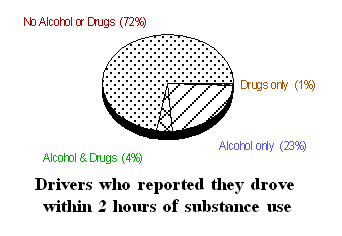















Traffic Tech #185: Drug Use and Driving Behaviors: Findings From the 1996 National Household Survey on Drug Abuse |
|---|
|

Number 185 December 1998
DRUG USE AND DRIVING BEHAVIORS
FINDINGS FROM THE 1996 NATIONAL HOUSEHOLD SURVEY ON DRUG ABUSE
Drug impaired driving has been identified as a threat to public health, but there is very little information on the prevalence and nature of illicit drug use and driving. The Substance Abuse and Mental Health Services Administration (SAMHSA) joined with the National Highway Traffic Safety Administration (NHTSA) to develop a special module to the 1996 National Household Survey on Drug Abuse (NHSDA) to gather some basic information.
The NHSDA is a primary source of statistical information on the use of illicit drugs in the United States, and has been given annually to a representative sample of the population aged 12 and older since 1971. The survey is used to estimate trends in the prevalence of substance use in America. It is a household interview, in which self-administered answer sheets are used to collect sensitive information. It also collects basic demographic information on employment, race or ethnicity, age, education, sources of income, marital status, and health status.
In 1996, the Driving Behaviors Module was added to the NHSDA to gather data on the occurrence of driving within two hours of drug or alcohol use. There were interviews with 11,847 persons aged 16 and older, who reported that they drove a car or other motor vehicle on at least one occasion in the past 12 months, and reported whether or not they drove within two hours of drug or alcohol use. This sample represents over 166 million drivers in America.

One percent of these drivers reported driving within two hours of drug use only; another four percent reported driving following both drug and alcohol use. In addition, 23 percent reported driving after alcohol use only.

The survey data are self-reported and their value depends on participants' truthfulness and memory. The principal findings are:
Driving within two hours of drug use (with or without alcohol) was more common among: drivers age 16-20; males; single (rather than married, divorced, widowed or separated); and the unemployed (rather than full- or part-time workers) in the past year.
Driving following drug use was more common among those who reported being arrested during the past year and those who reported being on probation during the past year than among those who did not report this criminal justice involvement.
On the most recent occasion for which drivers age 16 and older reported driving within two hours of marijuana use in the past year, driving most commonly occurred on smaller roads, in urban areas, on the weekend, and usually began between 6 pm and 11:59 pm. The most commonly reported reasons for driving were that they felt there was "no other way to get there," and that they were "not high enough to cause a crash."
More than half of drivers who reported driving after using marijuana believed that their ability to drive safely after using marijuana as "not at all" affected. Additionally, drivers 21 and older were more likely than younger ones to think that they were "no more likely" to be stopped by the police following marijuana use than on other driving occasions.
Among those who reported driving after marijuana use, the majority reported heavy, or weekly, marijuana use in the past year. By contrast, the majority of those who reported driving after alcohol use only reported low or medium alcohol use in the past month.
On the most recent occasion of driving following marijuana use, drivers in general most commonly reported driving after using only marijuana.
Drivers over the age of 21, however, were more likely than younger drivers to report combining marijuana with alcohol.
In the past year, among those who reported driving within two hours of using alcohol, with or without drugs, drivers age 16-20 were more likely than older drivers to report binge drinking (consuming five or more drinks) on the most recent occasion they drove after alcohol use. Furthermore, drivers age 16-20 also most commonly reported that they consumed their first and last drink in less than one hour on that occasion.
HOW TO ORDER
For a copy of Drug Use and Driving Behaviors: Findings from the 1996 National Household Survey on Drug Abuse, (35 pages plus appendices), prepared by the National Opinion Research Center, write to the Office of Research and Traffic Records, NHTSA, NTS-31, 400 Seventh Street, S.W., Washington, DC 20590, or send a fax to (202) 366-7096. Paul Tremont, Ph.D., was NHTSA's contract manager.
The report can be downloaded from NHTSA's homepage http://www.nhtsa.dot.gov
or SAMHSA's homepage http://www.samhsa.gov
U.S. Department
of Transportation
National Highway
Traffic Safety
Administration 400 Seventh Street, S.W. NTS-31
Washington, DC 20590
Traffic Tech is a publication to disseminate information about traffic safety programs, including evaluations, innovative programs, and new publications. Feel free to copy it as you wish. If you would like to receive a copy contact:
Linda Cosgrove, Ph.D., Editor, Evaluation Staff
Traffic Safety Programs
(202) 366-2759, fax (202) 366-7096
mailto:lcosgrove@nhtsa.dot.gov
